Translating Fire Impacts in Southwestern Amazonia into Economic Costs
Abstract
1. Introduction
2. Materials and Methods
2.1. Study Area
2.2. Data
2.2.1. Spatial Datasets
2.2.2. Non-Spatial Datasets
2.3. Data Analysis
2.3.1. Quantifying the Spatiotemporal Variability of Fire Dynamics
2.3.2. Fire Occurrence and Land Tenure Relationship
2.3.3. Estimating the Environmental, Social, and Economic Impacts of Fires
2.3.4. Assumptions and Uncertainties
3. Results
3.1. Spatiotemporal Variability of Fire Dynamics
3.2. Fire Occurrence and Land Tenure Relationship
3.3. Environmental, Social, and Economic Impacts of Fire
4. Discussion
4.1. Spatio-Temporal Variability of Fire Dynamics
4.2. Fire Occurrence and Land Tenure Relationship
4.3. Environmental, Social, and Economic Impacts of Fire
5. Conclusions
Author Contributions
Acknowledgments
Conflicts of Interest
Appendix A

| Data | Structure | Spatial Resolution | Period | Source |
|---|---|---|---|---|
| Burned area map | Raster | 250 m | 2008 to 2012 | TREES Group [15] |
| Aboveground carbon density map | Raster | 30 m | 2000s | Global Forest Watch Climate [46] |
| Land use and land cover map (LULC) | Raster | 30 m | 2010, 2008, and 2012 | TerraClass (INPE/Embrapa) [43,44] |
| Rivers and Roads | Polygons | Multi-scale | 2016 | IBGE [93] |
| Property boundaries and protected private areas (APPs and LRs) | Polygons | Multi-scale | 2017 | Sicar [81] |
| Rural module specifications | Table | - | 2013 | Incra [57] |
| Municipal boundaries | Polygons | Multi-scale | 2015 | IBGE [93] |
| Conservation units (UCs) and Indigenous Lands (ILs) | Polygons | Multi-scale | 2016 | MMA [94] e Funai [95] |
| Variable | Un. | Ag | 2008 | 2009 | 2010 | 2011 | 2012 | References |
|---|---|---|---|---|---|---|---|---|
| Morbidity cases (Jun–Dec) | # | 2776 | 2708 | 2545 | 2706 | 2657 | DATASUS * [58] | |
| Cost of morbidity | MUS$ | 34.25 | 24.87 | 28.76 | 36.58 | 41.27 | ||
| Fence recovery | US$/m | mn | 49.46 | 42.24 | 33.12 | 38.01 | 22.20 | DNIT * [59] |
| sd | 18.32 | 15.35 | 11.67 | 12.86 | 7.10 | |||
| Pasture reestablishment | US$/ha | mn | 883.27 1 | 883.27 1 | 883.27 | 883.27 1 | 883.27 1 | Townsand (2010) ** [60] |
| sd | 300.01 1 | 300.01 1 | 300.01 | 300.01 1 | 300.01 1 | |||
| Agriculture reestablishment | US$/ha | 813.62 1 | 813.62 1 | 813.62 | 813.62 1 | 813.62 1 | ||
| Maize productivity | t/ha | 1.75 | 1.83 | 2.00 | 2.21 | 2.27 | CONAB * [61] | |
| Maize price | US$/t | mn | 182.27 | 201.29 | 215.29 | 269.54 | 243.20 | CEPEA ** [63] |
| sd | 22.70 | 12.97 | 37.93 | 11.51 | 29.33 | |||
| Cassava productivity | t/ha | 21.71 | 18.73 | 20.67 | 19.00 | 15.33 | PAM-IBGE * [47] | |
| Cassava price | US$/t | mn | 62.39 | 86.62 | 134.14 | 103.60 | 107.09 | CEPEA ** [63] |
| sd | 2.44 | 17.27 | 9.79 | 12.69 | 27.72 | |||
| Cattle Densidy 2 | #/ha | 1.80 | 1.86 | 1.88 | 1.85 | 1.79 | PPM-IBGE * [96] /Terraclass ** [43] | |
| Cattle productivity | @/ha/y | 4.06 3 | 4.06 | 4.06 3 | 4.06 3 | 4.06 3 | EMBRAPA * [62] | |
| Cattle price | US$/@ | mn | 36.10 | 45.32 | 53.15 | 54.26 | 46.40 | CEPEA ** [63] |
| sd | 3.06 | 1.71 | 6.97 | 1.59 | 1.30 | |||
| CO2 price | €/t | mn | 13.69 3 | 13.69 | 11.98 | 13.06 | 7.50 | Carbon Emission Future ** [64] |
| sd | 0.68 3 | 0.68 | 5.42 | 3.35 | 0.72 | |||
| Euro change | US$/€ | mn | 1.15 | 1.59 | 1.40 | 1.24 | 1.23 | Banco Central Brasil * [65] |
| sd | 0.10 | 0.10 | 0.07 | 0.04 | 0.07 | |||
| Cumulative Inflation | %b.y | 32.51 | 32.46 | 32.41 | 32.35 | 32.29 | IPCA-IBGE * [97] | |
| US$ changes 4 | US$/R$ | 0.43 | 0.57 | 0.60 | 0.53 | 0.49 | IPEAData * [97] |
| Year | Total | Frequency | Recurrence | |||
|---|---|---|---|---|---|---|
| One | >One | 1 Years | 2 Years | 3 Years | ||
| 2008 | 218.85 | 218.85 | 161.82 | 57.04 | 2.47 | 0.53 |
| 2009 | 33.33 | 33.33 | 8.43 | 24.9 | 13.32 | 2.37 |
| 2010 | 2056.80 | 2056.8 | 1928.22 | 128.58 | 29.83 | 4.22 |
| 2011 | 178.52 | 178.52 | 135.74 | 42.78 | 8.5 | 0 |
| 2012 | 90.05 | 90.05 | 34.2 | 55.86 | 0 | 0 |
| Total | 2577.55 | 2577.55 | 2268.41 | 309.16 | 54.12 | 7.12 |
| Variable | Years | ||||
|---|---|---|---|---|---|
| 2008 | 2009 | 2010 | 2011 | 2012 | |
| Number of scars | 267 | 24 | 3521 | 324 | 146 |
| Total area (km2) | 218.85 | 33.33 | 2056.80 | 178.52 | 90.05 |
| Maximum area (km2) | 16.41 | 5.03 | 104.34 | 16.90 | 10.74 |
| Mean area (km2) | 0.82 | 1.39 | 0.58 | 0.55 | 0.62 |
| Minimum area (km2) | 0.07 | 0.07 | 0.02 | 0.0009 | 0.01 |
| Standard deviation | 1.50 | 1.38 | 2.54 | 1.28 | 1.39 |
| Variance | 225.09 | 190.09 | 644.56 | 162.88 | 192.70 |
| Anomaly of quantity | −0.44 | −0.62 | 1.99 | −0.40 | −0.53 |
| Anomaly of area | −1.32 | −2.54 | 2.39 | −2.07 | −2.21 |
| Distance (km) | 2008 | 2009 | 2010 | 2011 | 2012 | |||||
|---|---|---|---|---|---|---|---|---|---|---|
| Ri | Rd | Ri | Rd | Ri | Rd | Ri | Rd | Ri | Rd | |
| Minimum | 1.28 | 6.89 | 0.98 | 10.29 | 1.21 | 10.80 | 1.26 | 5.71 | 1.53 | 4.27 |
| Mean | 1.68 | 7.36 | 1.52 | 10.99 | 1.49 | 11.15 | 1.58 | 6.10 | 1.86 | 4.65 |
| Maximum | 5.39 | 28.88 | 3.72 | 41.86 | 6.20 | 56.54 | 5.69 | 34.28 | 5.73 | 24.81 |
| Standard deviation | 1.12 | 5.51 | 0.93 | 9.94 | 1.15 | 9.67 | 1.12 | 5.86 | 1.34 | 4.77 |
| Variance | 1.27 | 30.35 | 0.86 | 98.88 | 1.32 | 93.51 | 1.25 | 34.32 | 1.79 | 22.74 |
| LULC | 2008 | 2010 | 2012 | Average |
|---|---|---|---|---|
| Forest | 91.0% | 91.2% | 90.5% | 91.0% |
| Agriculture | 0.9% | 0.6% | 0.7% | 0.7% |
| Pasture | 8.1% | 8.2% | 8.8% | 8.3% |
| Class of Proprieties | Total | 2008 | 2009 | 2010 | 2011 | 2012 | Average |
|---|---|---|---|---|---|---|---|
| Smallholdings | 24964 | 658 (2.6%) | 80 (0.3%) | 6394 (25.6%) | 672 (2.7%) | 341 (1.4%) | 438 (1.8%) |
| Small | 5867 | 126 (2.1%) | 14 (0.2%) | 1368 (23.3%) | 91 (1.6%) | 42 (0.7%) | 68 (1.2%) |
| Medium | 593 | 35 (5.9%) | 3 (0.5%) | 215 (36.3%) | 22 (3.7%) | 16 (2.7%) | 19 (3.2%) |
| Large | 477 | 60 (12.6%) | 15 (3.1%) | 258 (54.1%) | 46 (9.6%) | 30 (6.3%) | 38 (8.0%) |
| Total | 31901 | 879 (2.8%) | 112 (0.4%) | 8235 (25.8%) | 831 (2.6%) | 429 (1.3%) | 563 (1.8%) |
| Type | Class (Acronym) | Nome | 2008 | 2009 | 2010 | 2011 | 2012 |
|---|---|---|---|---|---|---|---|
| UIP | National Park (PARNA) | Serra do Divisor | 0.00 | 0.00 | 0.02 | 0.00 | 0.00 |
| USU | Area of Relevant Ecological Interest (ARIE) | Seringal Nova Esperaça | 0.00 | 0.00 | 1.26 | 0.00 | 0.00 |
| USU | National Forest (FLONA) | Santa Rosa do Purus | 0.00 | 0.00 | 1.87 | 0.00 | 0.00 |
| USU | Extractive Reserve (RESEX) | Cazumbá-Iracema | 0.64 | 0.00 | 7.76 | 0.00 | 0.00 |
| USU | Extractive Reserve (RESEX) | Chico Mendes | 0.37 | 0.00 | 34.73 | 0.59 | 0.00 |
| Total | 1.00 | 0.00 | 45.63 | 0.59 | 0.00 |
| Terra Indigena | 2008 | 2009 | 2010 | 2011 | 2012 |
|---|---|---|---|---|---|
| Alto Rio Purus | 0.00 | 0.00 | 0.33 | 0.00 | 0.00 |
| Cabeceira do Rio Acre | 0.00 | 0.00 | 0.00 | 0.00 | 0.00 |
| Igarapé do Caucho | 0.00 | 0.00 | 0.96 | 0.00 | 0.00 |
| Kampa do Rio Amonea | 0.00 | 0.00 | 2.93 | 0.00 | 0.00 |
| Kampa e Isolados do Rio Envira | 0.00 | 0.00 | 0.15 | 0.00 | 0.00 |
| Katukina/Kaxinawá | 0.00 | 0.00 | 0.15 | 0.00 | 0.00 |
| Kaxinawá Colônia Vinte e Sete | 0.00 | 0.00 | 0.29 | 0.00 | 0.00 |
| Kaxinawá do Rio Humaitá | 0.00 | 0.00 | 0.13 | 0.00 | 0.00 |
| Mamoadate | 0.00 | 0.00 | 11.20 | 3.64 | 0.00 |
| Poyanawa | 0.00 | 0.00 | 6.46 | 0.00 | 1.03 |
| Total | 0.00 | 0.00 | 22.59 | 3.64 | 1.03 |
| Type of Impact | 2008 | 2009 | 2010 | 2011 | 2012 | Average | ||||||
|---|---|---|---|---|---|---|---|---|---|---|---|---|
| Fence | 2.72 | (9.3%) | 0.55 | (11%) | 29.27 | (12%) | 2.14 | (9.7%) | 1.32 | (16.9%) | 1.68 | (10.5%) |
| Reestablishment | 3.70 | (12.7%) | 0.63 | (12.4%) | 23.63 | (9.7%) | 3.05 | (13.8%) | 1.67 | (21.4%) | 2.26 | (14.1%) |
| Production | 1.78 | (6.1%) | 0.29 | (5.7%) | 13.11 | (5.4%) | 1.72 | (7.8%) | 1.04 | (13.3%) | 1.21 | (7.5%) |
| CO2 emission | 20.49 | (70.2%) | 3.10 | (61.5%) | 176.77 | (72.6%) | 14.52 | (65.8%) | 3.11 | (39.8%) | 10.31 | (64.3%) |
| Respiratory | 0.49 | (1.7%) | 0.47 | (9.4%) | 0.57 | (0.2%) | 0.65 | (2.9%) | 0.67 | (8.6%) | 0.57 | (3.6%) |
| Total | 29.17 | ± 5.56 | 5.04 | ± 0.94 | 243.36 | ± 85.05 | 22.08 | ± 5.26 | 7.81 | ± 1.30 | 16.03 | ± 3.27 |
| %GDP | 1.10% | ± 0.21 | 0.16% | ± 0.03 | 7.03% | ± 2.45 | 0.59% | ± 0.14 | 0.19% | ± 0.03 | 0.5% | ± 0.10 |

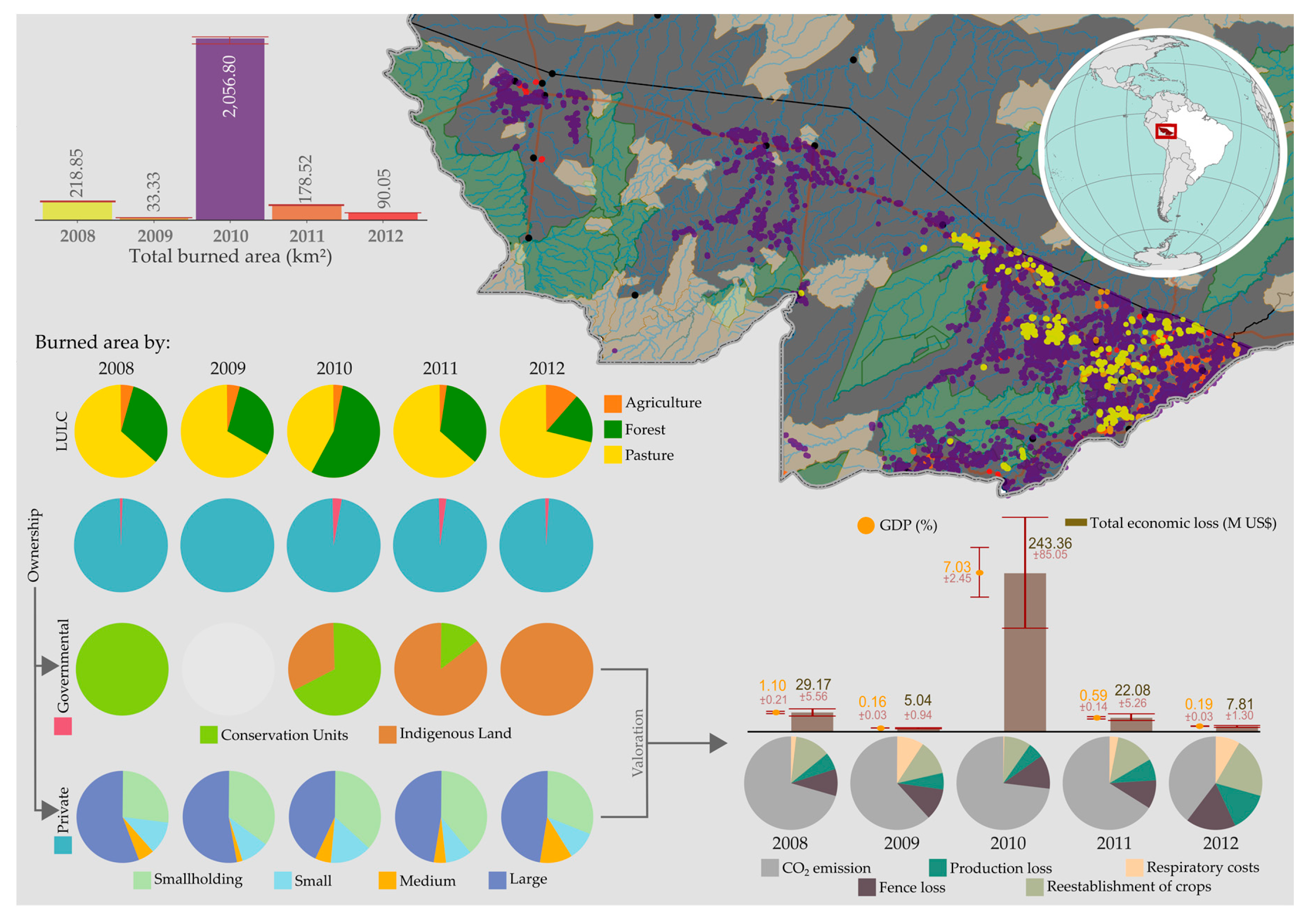
References
- Pivello, V.R. The Use of Fire in the Cerrado and Amazonian Rainforests of Brazil: Past and Present. Fire Ecol. 2011, 7, 24–39. [Google Scholar]
- Bush, M.; Colinvaux, P.; Miller, M.; Moreno, J.; Bush, M.; De Oliveira, P. Amazonian paleoecological histories: One hill, three watersheds. Palaeogeogr. Palaeoclim. Palaeoecol. 2004, 214, 359–393. [Google Scholar] [CrossRef]
- Bush, M.B.; Silman, M.R.; De Toledo, M.B.; Listopad, C.; Gosling, W.D.; Williams, C.; E De Oliveira, P.; Krisel, C. Holocene fire and occupation in Amazonia: Records from two lake districts. Philos. Trans. R. Soc. B Boil. Sci. 2007, 362, 209–218. [Google Scholar] [CrossRef] [PubMed]
- De Mendonça, M.J.C.; Diaz, M.D.C.V.; Nepstad, D.; Da Motta, R.S.; Alencar, A.; Gomes, J.C.; Ortiz, R.A. The economic cost of the use of fire in the Amazon. Ecol. Econ. 2004, 49, 89–105. [Google Scholar] [CrossRef]
- da Motta, R.S.; Mendonça, M.J.C.; Nepstad, D.; del C.V. Diaz, M.; Alencar, A.; Gomes, J.C.; Ortiz, R.A. Text for Discussion (TD) 912: The economic cost of fire in the Amazon; The Institute for Applied Economic Research (IPEA): Rio de Janeiro, Brasil, 2002; ISBN 1415-4765. [Google Scholar]
- Santín, C.; Doerr, S.H. Fire effects on soils: The human dimension. Philos. Trans. R. Soc. B Boil. Sci. 2016, 371, 20150171. [Google Scholar] [CrossRef] [PubMed]
- Braz, A.M.D.S.; Fernandes, A.R.; Alleoni, L.R.F. SOIL ATTRIBUTES AFTER THE CONVERSION FROM FOREST TO PASTURE IN AMAZON. Degrad. Dev. 2011, 24, 33–38. [Google Scholar] [CrossRef]
- de M. Falleiro, R.; Santana, M.T.; Berni, C.R. As Contribuições do Manejo Integrado do Fogo para o Controle dos Incêndios Florestais nas Terras Indígenas do Brasil. Biodiversidade Bras. 2016, 6, 88–105. Available online: http://www.icmbio.gov.br/revistaeletronica/index.php/BioBR/article/view/655 (accessed on 22 March 2019).
- Posey, D.A. Indigenous management of tropical forest ecosystems: the case of the Kayapó indians of the Brazilian Amazon. Agrofor. Syst. 1985, 3, 139–158. [Google Scholar] [CrossRef]
- Mistry, J.; Bilbao, B.A.; Berardi, A. Community owned solutions for fire management in tropical ecosystems: case studies from Indigenous communities of South America. Philos. Trans. R. Soc. B: Boil. Sci. 2016, 371, 20150174. [Google Scholar] [CrossRef]
- Marengo, J.A.; Espinoza, J.C. Extreme seasonal droughts and floods in Amazonia: Causes, trends and impacts. Int. J. Clim. 2015, 36, 1033–1050. [Google Scholar] [CrossRef]
- Brando, P.M.; Balch, J.K.; Nepstad, D.C.; Morton, D.C.; Putz, F.E.; Coe, M.T.; Silvério, D.; Macedo, M.N.; Davidson, E.A.; Nóbrega, C.C.; et al. Abrupt increases in Amazonian tree mortality due to drought–fire interactions. Proc. Natl. Acad. Sci. 2014, 111, 6347–6352. [Google Scholar] [CrossRef]
- Lima, A.; Silva, T.S.F.; Aragão, L.E.O.E.C.D.; De Feitas, R.M.; Adami, M.; Formaggio, A.R.; Shimabukuro, Y.E. Land use and land cover changes determine the spatial relationship between fire and deforestation in the Brazilian Amazon. Appl. Geogr. 2012, 34, 239–246. [Google Scholar] [CrossRef]
- Aragão, L.E.O.C.; Malhi, Y.; Roman-Cuesta, R.M.; Saatchi, S.; Anderson, L.O.; Shimabukuro, Y.E.; Roman-Cuesta, R.M. Spatial patterns and fire response of recent Amazonian droughts. Geophys. Res. Lett. 2007, 34. [Google Scholar] [CrossRef]
- Anderson, L.O.; Aragão, L.E.O.C.; Gloor, M.; Arai, E.; Adami, M.; Saatchi, S.S.; Malhi, Y.; Shimabukuro, Y.E.; Barlow, J.; Berenguer, E.; et al. Disentangling the contribution of multiple land covers to fire-mediated carbon emissions in Amazonia during the 2010 drought. Glob. Biogeochem. Cycles 2015, 29, 1739–1753. [Google Scholar] [CrossRef] [PubMed]
- Aragao, L.E.O.C.; Anderson, L.O.; Fonseca, M.G.; Rosan, T.M.; Vedovato, L.B.; Wagner, F.H.; Silva, C.V.J.; Junior, C.H.L.S.; Arai, E.; Aguiar, A.P.; et al. 21st Century drought-related fires counteract the decline of Amazon deforestation carbon emissions. Nat Commun 2018, 9, 536. [Google Scholar] [CrossRef]
- Li, W.; Fu, R.; Dickinson, R.E. Rainfall and its seasonality over the Amazon in the 21st century as assessed by the coupled models for the IPCC AR4. J. Geophys. Res. Phys. 2006, 111. [Google Scholar] [CrossRef]
- Junior, C.H.L.S.; Aragao, L.E.O.C.; Fonseca, M.G.; Almeida, C.T.; Vedovato, L.B.; Anderson, L.O. Deforestation-Induced Fragmentation Increases Forest Fire Occurrence in Central Brazilian Amazonia. Forests 2018, 9, 305. [Google Scholar] [CrossRef]
- Aragão, L.E.O.C.; Marengo, J.A.; Cox, P.M.; Betts, R.A.; Costa, D.; Kaye, N.; Alves, L.; Smith, L.; Cavalcanti, I.F.A.; Sampaio, G.; et al. Assessing the Influence of Climate Extremes on Ecosystems and Human Health in Southwestern Amazon Supported by the PULSE-Brazil Platform. Am. J. Clim. Chang. 2016, 5, 399–416. [Google Scholar] [CrossRef]
- Da Silva, R.G.; De Lima, J.E. Avaliação econômica da poluição do ar na Amazônia Ocidental: um estudo de caso do Estado do Acre. Rev. de Econ. e Sociol. Rural. 2006, 44, 157–178. [Google Scholar] [CrossRef]
- Smith, L.T.; Aragão, L.E.O.C.; Sabel, C.E.; Nakaya, T. Drought impacts on children’s respiratory health in the Brazilian Amazon. Sci. Rep. 2014, 4. [Google Scholar] [CrossRef] [PubMed]
- Da Rocha, V.R.; Yamasoe, M.A. Estudo da variabilidade espacial e temporal da profundidade óptica do aerossol obtida com o MODIS sobre a região amazônica. Rev. Bras. de Meteorol. 2013, 28, 210–220. [Google Scholar] [CrossRef]
- Nepstad, D.; McGrath, D.; Stickler, C.; Alencar, A.; Azevedo, A.; Swette, B.; Bezerra, T.; DiGiano, M.; Shimada, J.; Da Motta, R.S.; et al. Slowing Amazon deforestation through public policy and interventions in beef and soy supply chains. Science 2014, 344, 1118–1123. [Google Scholar] [CrossRef]
- Lewis, S.L.; Brando, P.M.; Phillips, O.; Van Der Heijden, G.M.F.; Nepstad, D. The 2010 Amazon Drought. Science 2011, 331, 554. [Google Scholar] [CrossRef]
- Marengo, J.A.; Soares, W.R.; Tomasella, J.; Alves, L.M.; Rodriguez, D.A. The drought of 2010 in the context of historical droughts in the Amazon region. Geophys. Res. Lett. 2011, 38. [Google Scholar] [CrossRef]
- Dolman, D.I.; Brown, I.F.; Anderson, L.O.; Warner, J.F.; Marchezini, V.; Santos, G.L.P. Re-thinking socio-economic impact assessments of disasters: The 2015 flood in Rio Branco, Brazilian Amazon. Int. J. Dis. Risk Reduct. 2018, 31, 212–219. [Google Scholar] [CrossRef]
- World Resources Report: Decision Making in a Changing Climate. PsycEXTRA Dataset 2013.
- Brown, I.F.; Schroeder, W.; Setzer, A.; Maldonado, M.D.L.R.; Pantoja, N.; Duarte, A.; Marengo, J. Monitoring fires in southwestern Amazonia Rain Forests. Eos Trans. AGU 2006, 87, 253. [Google Scholar] [CrossRef]
- Reis, V.; Gomes, J.J.; Santos Neto, L.A.; Paiva, E.; Pimental, A.; Marluce, Y.; Marinho, S.C. Operation Manual of the Situation Unit for the Monitoring of Hydrometeorological Events of the Acre State; State Secretary for the Environment - SEMA: Rio Branco, AC, Brazil, 2015; p. 112.
- UNIDSR Sendai Framework for Disaster Risk Reduction 2015 – 2030. Sendai, Japan, 2015; p. 37. Available online: https://www.unisdr.org/we/inform/publications/43291 (accessed on 13 July 2018).
- Wallemacq, P.; House, R.; McClean, D.; Below, R. Economic Losses, Poverty e Disasters (1998–2017); UNISDR: Geneva, Switzerland, 2018; p. 31. [Google Scholar]
- Kumar, P.; Brondizio, E.; Gatzweiler, F.; Gowdy, J.; De Groot, D.; Pascual, U.; Reyers, B.; Sukhdev, P. The economics of ecosystem services: From local analysis to national policies. Curr. Opin. Environ. Sustain. 2013, 5, 78–86. [Google Scholar] [CrossRef]
- Mendelsohn, R.; Olmstead, S. The Economic Valuation of Environmental Amenities and Disamenities: Methods and Applications. Annu. Rev. Environ. Resour. 2009, 34, 325–347. [Google Scholar] [CrossRef]
- BRASIL Determining territorial boundaries. 2018. Available online: http://www.in.gov.br/materia/-/asset_publisher/Kujrw0TZC2Mb/content/id/27932200 (accessed on 13 July 2018).
- OBT-INPE Taxas anuais de desmatamento na Amazônia Legal brasileira. Available online: http://www.obt.inpe.br/prodes/dashboard/prodes-rates.html (accessed on 13 July 2018).
- Rodrigues, M.A. Dinâmica espacial do desmatamento no estado do Acre entre 1999 e 2010: o papel do Zoneamento Ecológico Econômico. Doutorado Thesis, UNICAMP, Campinas, SP, Brazil, 2014. [Google Scholar]
- Alvares, C.A.; Stape, J.L.; Sentelhas, P.C.; Gonçalves, J.L.D.M.; Sparovek, G. Köppen’s climate classification map for Brazil. Meteorol. Z. 2013, 22, 711–728. [Google Scholar] [CrossRef]
- Duarte, A.F. Aspectos da climatologia do Acre, Brail, com base no intervalo 1971–2000. Rev. Bras. Meteorol. 2006, 21, 308–317. Available online: http://www.rbmet.org.br/port/revista/revista_artigo.php?id_artigo=219 (accessed on 1 January 2018).
- Anderson, L.O.; Cheek, D.; Aragao, L.E.; Andere, L.; Duarte, B.; Salazar, N.; Lima, A.; Duarte, V.; Arai, E. Development of a Point-based Method for Map Validation and Confidence Interval Estimation: A Case Study of Burned Areas in Amazonia. J. Remote Sens. GIS 2017, 06. [Google Scholar] [CrossRef]
- Anderson, L.O.; Aragão, L.E.O.C.; Lima, A.D.; Shimabukuro, Y.E. Detecção de cicatrizes de áreas queimadas baseada no modelo linear de mistura espectral e imagens índice de vegetação utilizando dados multitemporais do sensor MODIS/TERRA no estado do Mato Grosso, Amazônia brasileira. Acta Amaz. 2005, 35, 445–456. [Google Scholar] [CrossRef]
- Shimabukuro, Y.E.; Duarte, V.; Arai, E.; Freitas, R.M.; Lima, A.; Valeriano, D.M.; Brown, I.F.; Maldonado, M.L.R. Fraction images derived from Terra Modis data for mapping burnt areas in Brazilian Amazonia. Int. J. Remote Sens. 2009, 30, 1537–1546. [Google Scholar] [CrossRef]
- Shimabukuro, Y.E.; Smith, J.A. The least-squares mixing models to generate fraction images derived from remote sensing multispectral data. IEEE Trans. Geosci. Remote Sens. 1991, 29, 16–20. [Google Scholar] [CrossRef]
- INPE TerraClass. Available online: http://www.inpe.br/cra/projetos_pesquisas/dados_terraclass.php (accessed on 9 July 2018).
- Almeida, C.A.D.; Coutinho, A.C.; Esquerdo, J.C.D.M.; Adami, M.; Venturieri, A.; Diniz, C.G.; Dessay, N.; Durieux, L.; Gomes, A.R. High spatial resolution land use and land cover mapping of the Brazilian Legal Amazon in 2008 using Landsat-5/TM and MODIS data. Acta Amaz. 2016, 46, 291–302. [Google Scholar] [CrossRef]
- Coutinho, A.C.; Almeida, C.; Venturieri, A.; Esquerdo, J.C.D.M.; Silva, M. Use and Land Cover in Deforested Areas of the Legal Amazon: TerraClass 2008; Embrapa: Brasilia, DF, Brazil, 2013; ISBN 978-85-7035-180-7. [Google Scholar]
- Baccini, A.; Walker, W.; Carvalho, L.; Farina, M.; Sulla-Menashe, D.; Houghton, R.A. Tropical forests are a net carbon source based on aboveground measurements of gain and loss. Science 2017, 358, 230–234. [Google Scholar] [CrossRef]
- IBGE PAM - Produção Agrícola Municipal. Available online: https://sidra.ibge.gov.br/pesquisa/pam/tabelas (accessed on 9 July 2018).
- Vian, A.L.; Bredemeier, C.; Fochesatto, E.; Drum, M.A.; Pagliarini, N.H.F. Estimating maize biomass through digital images and vegetation sensor. Presented at XXXI CNMS, Bento Gonçalvez, RS, Brazil, 25–29 September 2016. [Google Scholar]
- Instituto FNP. Agrianual 2012: Brazilian Agriculture Yearbook; FNP Consultoria: São Paulo, SP, Brazil, 2012; ISBN 9988-7777-7-9. [Google Scholar]
- Fernandes, F.D.; Guimarães Júnior, R.; Vieira, E.A.; de F. Fialho, J.; Ramos, A.K.B.; Faleiro, F.G. Productivity of biomass of cassava genotypes in Distrito Federal. 2009. [Google Scholar]
- Redin, M. Biochemical composition and decomposition of shoot and roots from comercial crops and cover soil plants. Ph.D. Dissertation, UFSM, Santa Maria, RS, Brazil, 2010. [Google Scholar]
- Vuolo, J.H. Fundamentals of Error Theory; 2a.; Edgard Blücher Ltda: São Paulo, Brazil, 1996; ISBN 85-212-0056-0. [Google Scholar]
- Boone Kauffman, J.; Cummings, D.L.; Ward, D.E. Fire in the Brazilian Amazon 2. Biomass, nutrient pools and losses in cattle pastures. Oecologia 1998, 113, 415–427. [Google Scholar] [CrossRef] [PubMed]
- BRASIL New brazilian forest code. 2012. Available online: http://www.planalto.gov.br/ccivil_03/_Ato2011-2014/2012/Lei/L12651.htm (accessed on 13 July 2018).
- Soares-Filho, B.; Rajao, R.; Macedo, M.; Carneiro, A.; Costa, W.; Coe, M.; Rodrigues, H.; Alencar, A. Cracking Brazil’s Forest Code. Science 2014, 344, 363–364. [Google Scholar] [CrossRef] [PubMed]
- BRASIL Regulates the constitutional provisions related to agrarian reform. 1993. Available online: http://www.planalto.gov.br/CCIVIL_03/LEIS/L8629.htm (accessed on 13 July 2018).
- INCRA Tabela com módulo fiscal dos municípios. Available online: http://www.incra.gov.br/tabela-modulo-fiscal (accessed on 9 July 2018).
- Ministério da Saúde Informações de Saúde (TABNET). Available online: http://www2.datasus.gov.br/DATASUS/index.php?area=02 (accessed on 9 July 2018).
- DNIT SICRO2. Available online: http://www.dnit.gov.br/custos-e-pagamentos/sicro-2/norte/norte (accessed on 30 June 2018).
- Townsend, C.R.; de L. Costa, N. Aspectos econômicos da recuperação de pastagens na Amazônia brasileira. Amaz. Ciênc. Desenvolv. 2010, 5, 27–50. Available online: https://www.alice.cnptia.embrapa.br/bitstream/doc/879776/1/BASAClaudioAspectoseconomicosRecpastCDN10AspectosEconomicosRe1.pdf (accessed on 10 January 2018).
- CONAB Grãos - série histórica. Available online: https://portaldeinformacoes.conab.gov.br/index.php/safras/safra-serie-historica (accessed on 9 January 2018).
- de Sá, C.P.; de Andrade, C.M.S.; Valentim, J.F. Economic Analysis for Cattle Ranching in Improved Pastures in Acre; EMBRAPA: Rio Branco, AC, Brazil, 2010; ISSN 0100-9915. [Google Scholar]
- CEPEA Consulta ao banco de dados de série de preços. Available online: https://www.cepea.esalq.usp.br/br/consultas-ao-banco-de-dados-do-site.aspx (accessed on 9 January 2018).
- Markets Insiders Historical prices co2 emission. Available online: https://markets.businessinsider.com/commodities/historical-prices/co2-emissionsrechte/euro/15.11.2007_31.12.2009 (accessed on 30 September 2018).
- BCB Cotações e boletins. Available online: https://www4.bcb.gov.br/pec/taxas/port/ptaxnpesq.asp?id=txcotacao (accessed on 9 January 2018).
- Morton, D.C.; Le Page, Y.; DeFries, R.; Collatz, G.J.; Hurtt, G.C. Understorey fire frequency and the fate of burned forests in southern Amazonia. Philos. Trans. R. Soc. B Biol. Sci. 2013, 368, 20120163. [Google Scholar] [CrossRef] [PubMed]
- Silva, S.S.D.; Fearnside, P.M.; de A. Graça, P.M.L.; Brown, I.F.; Alencar, A.; de Melo, A.W.F. Dynamics of forest fires in the southwestern Amazon. For. Ecol. Manag. 2018, 424, 312–322. [Google Scholar] [CrossRef]
- de L. Costa, N. Uso do Fogo no Manejo de Pastagens. AgroLink 2008, 12. Available online: https://www.agrolink.com.br/colunistas/coluna/uso-do-fogo-no-manejo-de-pastagens_385477.html (accessed on 15 January 2018).
- Costa, M.R.G.F.; Cândido, M.J.D.; de S. Carneiro, M.S.; de Morais Neto, L.B.; Magalhães, J.A.; de L. Costa, N. Uso do fogo em pastagens naturais. Pubvet 2011, 5. [Google Scholar] [CrossRef]
- Godar, J.; Gardner, T.A.; Tizado, E.J.; Pacheco, P. Actor-specific contributions to the deforestation slowdown in the Brazilian Amazon. Proc. Natl. Acad. Sci. 2014, 111, 15591–15596. [Google Scholar] [CrossRef]
- Aragão, L.E.O.C.; Shimabukuro, Y.E. The Incidence of Fire in Amazonian Forests with Implications for REDD. Science 2010, 328, 1275–1278. [Google Scholar] [CrossRef] [PubMed]
- Weinhold, D.; Reis, E.J.; Vale, P.M. Boom-bust patterns in the Brazilian Amazon. Glob. Environ. Change 2015, 35, 391–399. [Google Scholar] [CrossRef]
- Tritsch, I.; Arvor, D. Transition in environmental governance in the Brazilian Amazon: emergence of a new pattern of socio-economic development and deforestation. Land Use Policy 2016, 59, 446–455. [Google Scholar] [CrossRef]
- Caviglia-Harris, J.; Sills, E.; Bell, A.; Harris, D.; Mullan, K.; Roberts, D. Busting the Boom–Bust Pattern of Development in the Brazilian Amazon. World Dev. 2016, 79, 82–96. [Google Scholar] [CrossRef]
- Hall, S.C.; Caviglia-Harris, J. Agricultural development and the industry life cycle on the Brazilian frontier. Environ. Dev. Econ. 2013, 18, 326–353. [Google Scholar] [CrossRef]
- Guedes, G.R.; Brondízio, E.S.; Barbieri, A.F.; Anne, R.; Penna-Firme, R.; D’Antona, Á.O. Poverty and Inequality in the Rural Brazilian Amazon: A Multidimensional Approach. Hum. Ecol. 2012, 40, 41–57. [Google Scholar] [CrossRef]
- Andela, N.; Morton, D.C.; Giglio, L.; Chen, Y.; van der Werf, G.R.; Kasibhatla, P.S.; DeFries, R.S.; Collatz, G.J.; Hantson, S.; Kloster, S.; et al. A human-driven decline in global burned area. Science 2017, 356, 1356–1362. [Google Scholar] [CrossRef] [PubMed]
- Sills, E.O.; Atmadja, S.S.; Sassi, C.; Duchelle, A.E.; Kweka, D.L.; Resosudarmo, I.A.P.; Sunderlin, W.D. (Eds.) REDD+ on the Ground: A Case Book of Subnational Initiatives across the Globe; Center for International Forestry Research (CIFOR): Bogor, Indonesia, 2014; ISBN 978-602-1504-55-0. [Google Scholar]
- BID BR-L1289: The Acre Sustainable Development Program (PDSA-II). Available online: https://www.iadb.org/fr/project/0?projectNumber=2928/OC-BR;BR-L1289 (accessed on 30 September 2018).
- de S. Costa, F.; Amaral, E.F. Inventory of Anthropogenic Emissions and Greenhouse Gas Sinks of the State of Acre: Base Year 2012; Embrapa: Brasilia, DF, Brazil, 2014; ISBN 978-85-7035-433-4. [Google Scholar]
- SFB Sistema Nacional de Cadastro Ambiental Rural – SICAR. Available online: http://www.car.gov.br/publico/imoveis/index (accessed on 9 January 2018).
- CEGDRA Integrated Plan for the Prevention, Control and Combat of Burning and Forest Fires in the State of Acre, 3rd ed.; SEMA: Rio Branco, AC, Brazil, 2013; ISBN 577.4098112.
- MAPA Sector Plan for Mitigation and Adaptation to Climate Change for the Consolidation of a Low Carbon Economy in Agriculture: ABC (Low Carbon Agriculture) Plan; MAPA/ACS: Brasilia, DF, Brazil, 2012; ISBN 978-85-7991-062-0.
- Leonel, M. O uso do fogo: o manejo indígena e a piromania da monocultura. Estud. Av. 2000, 14, 231–250. [Google Scholar] [CrossRef]
- Graf, R. Agroecology of the indigenous peoples of Acre: Ethics of well-being. Presented at the AGROECOL, Dourados, MS, Brazil, 16–19 November 2016. [Google Scholar]
- BRASIL National System of Conservation Units. 2000. Available online: http://www.planalto.gov.br/ccivil_03/LEIS/L9985.htm (accessed on 13 July 2018).
- Torres, F.T.P.; Lima, G.S.; Costa, A.D.G.; Félix, G.D.A.; Silva Júnior, M.R. Profile of forest fires in Brazilian Conservation Units from 2008 to 2012. FLORESTA 2017, 46, 531. [Google Scholar] [CrossRef]
- Kurtis, J.N.; Joel, A.C.; Birgit, E.P.; Joshua, J.P. LANDFIRE 2010 - updated data to support wildfire and ecological management. IEEE 2013. Available online: http://pubs.er.usgs.gov/publication/70048192 (accessed on 19 January 2018).
- Salimon, C.I.; Putz, F.E.; Menezes-Filho, L.; Anderson, A.; Silveira, M.; Brown, I.F.; Oliveira, L.C. Estimating state-wide biomass carbon stocks for a REDD plan in Acre, Brazil. For. Ecol. Manag. 2011, 262, 555–560. [Google Scholar] [CrossRef]
- Nepstad, D.; Moutinho, P.; Boyd, W.; Azevedo, A.; Bezerra, T.; Smid, B.; Stabile, M.C.C.; Stickler, C.; Stella, O. Unlocking jurisdictional REDD+ as a policy framework for low-emission rural development: research results and recommendations for governments. 2012, p. 22. Available online: https://earthinnovation.org/wp-content/uploads/2014/09/re-framing_redd_english.pdf (accessed on 10 January 2018).
- Silva, R.G.D.; Silveira, B.C.; Silveira, A.O.D.A. Relationship between burnings and respiratory morbidities in Acre from 1998 to 2005: A spatial approach 2008. Presented at XLVI Sober, Rio Branco, AC, Brazil, 2008; Available online: http://www.sober.org.br/palestra/9/139.pdf (accessed on 13 July 2018).
- IBGE Censo Demográfico 2010. Available online: https://censo2010.ibge.gov.br/resultados.html (accessed on 9 January 2018).
- IBGE Bases e referências: Malhas digitais. Available online: https://mapas.ibge.gov.br/bases-e-referenciais/bases-cartograficas/malhas-digitais (accessed on 9 January 2018).
- MMA Download de dados geográficos. Available online: http://mapas.mma.gov.br/i3geo/datadownload.htm (accessed on 30 September 2018).
- FUNAI Geoprocessamento. Terras Indígenas do Brasil. Available online: http://www.funai.gov.br/index.php/shape (accessed on 9 January 2018).
- IBGE Pesquisa da Pecuária Municipal. Available online: https://sidra.ibge.gov.br/tabela/3939 (accessed on 30 September 2018).
- IPEA IPEA-Data. Available online: http://www.ipeadata.gov.br/Default.aspx (accessed on 30 September 2018).
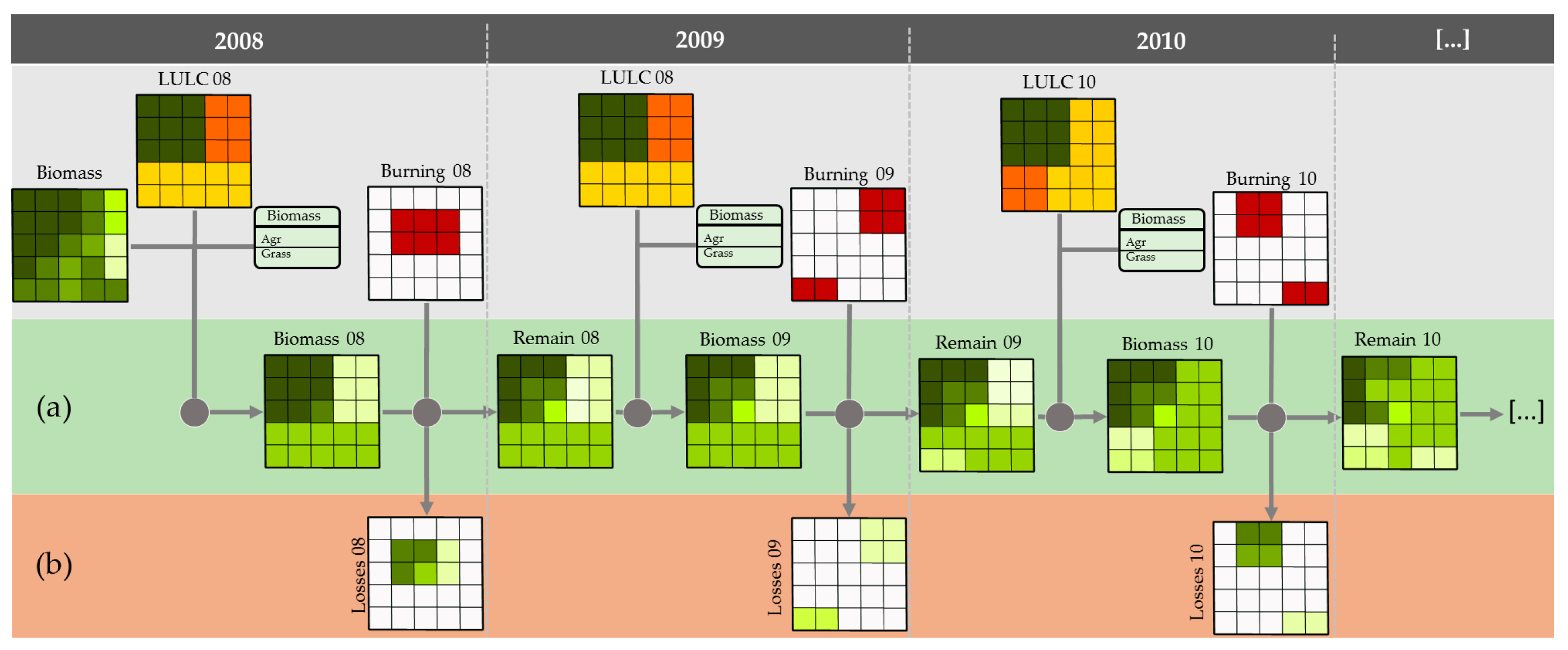
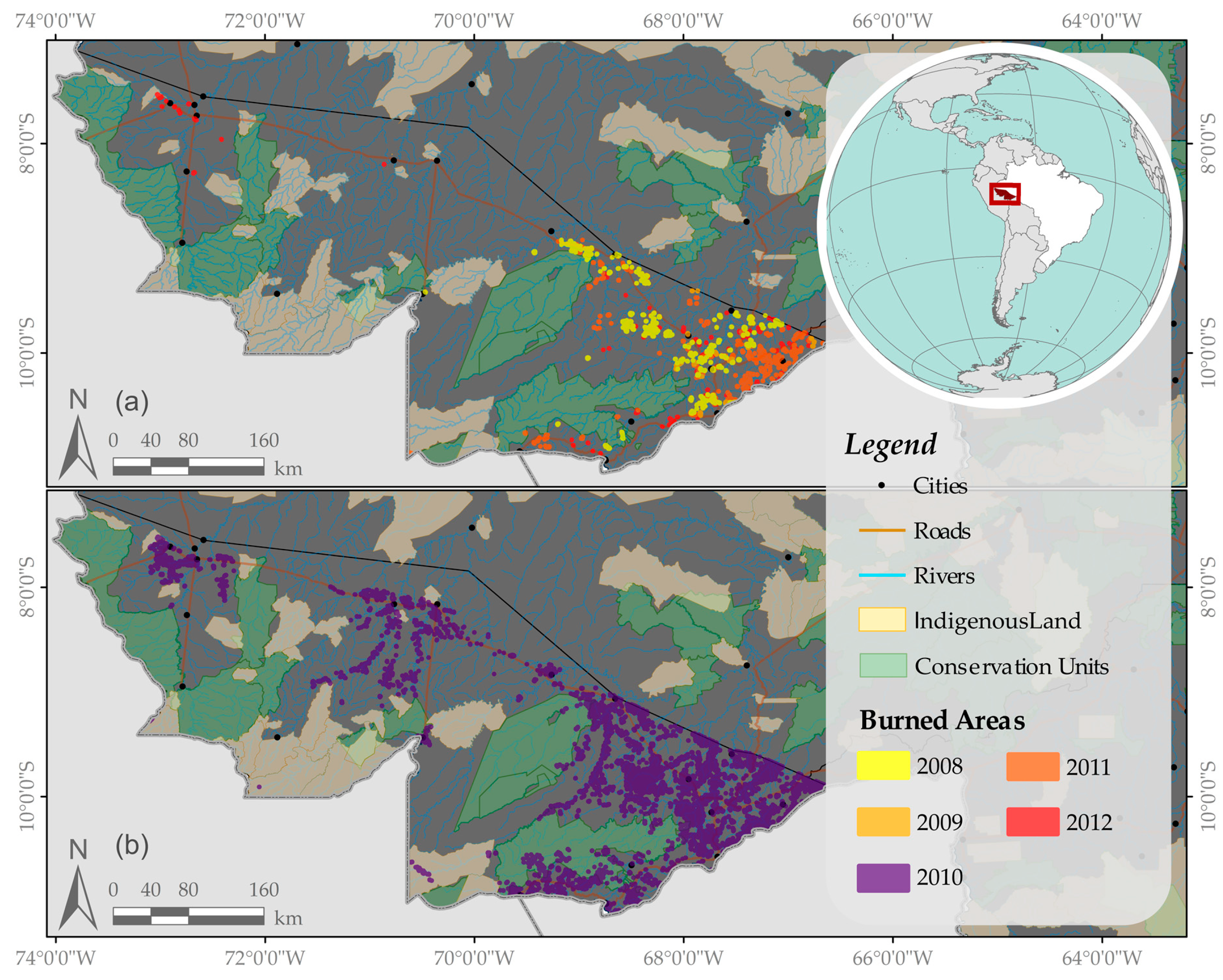
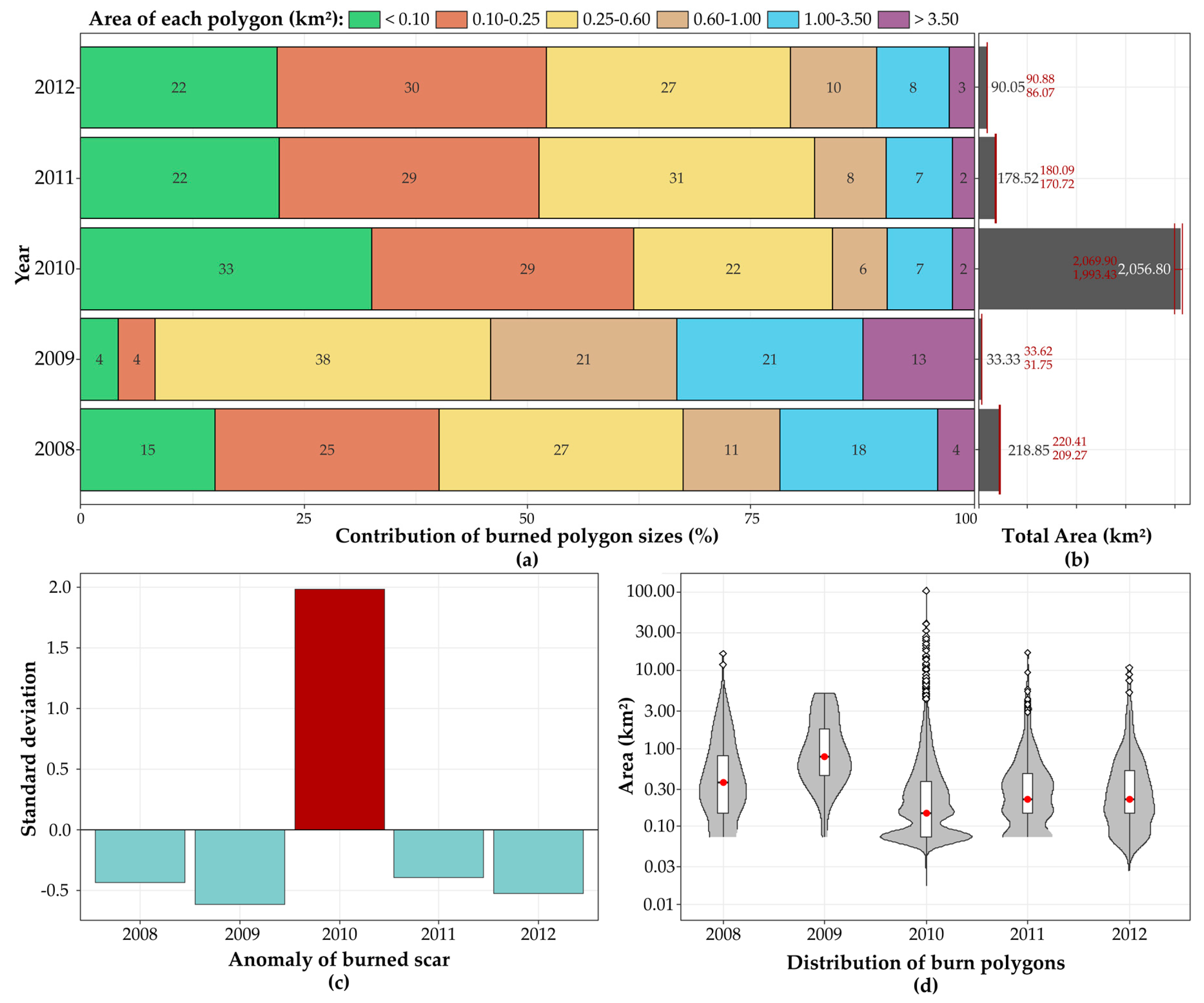

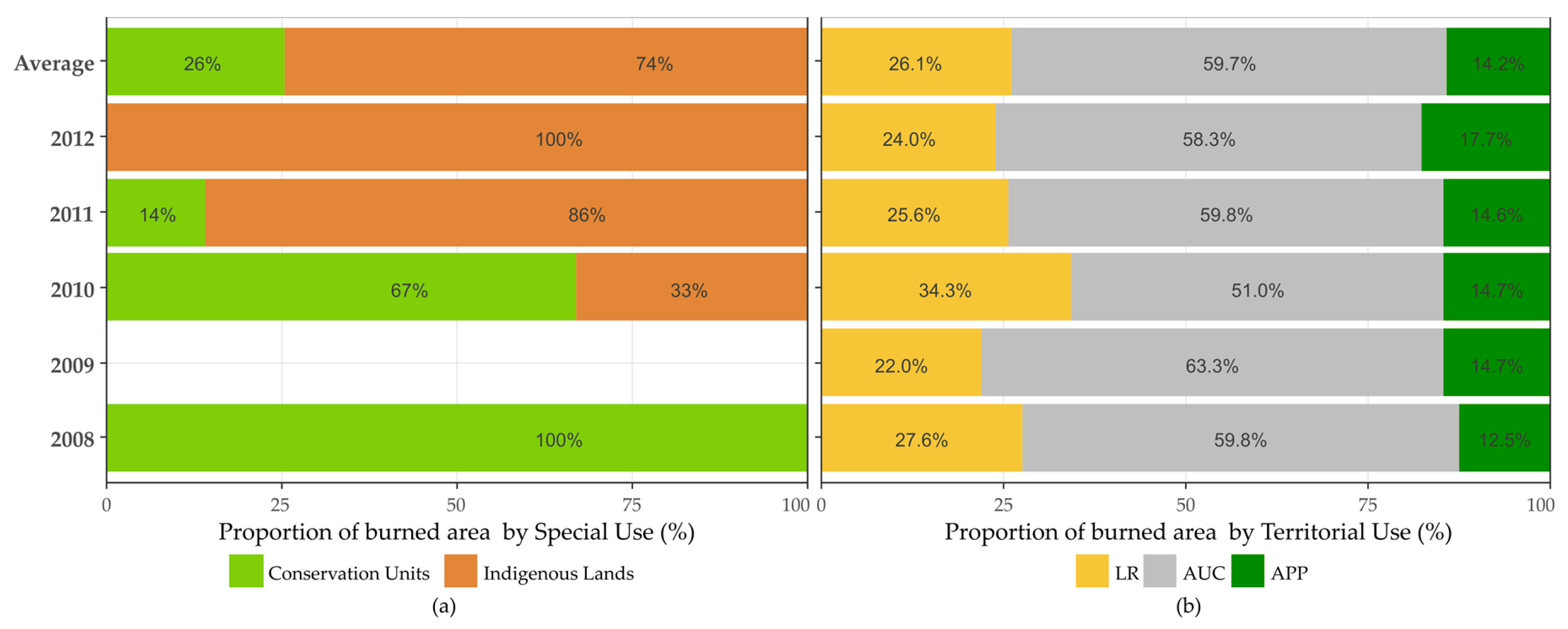
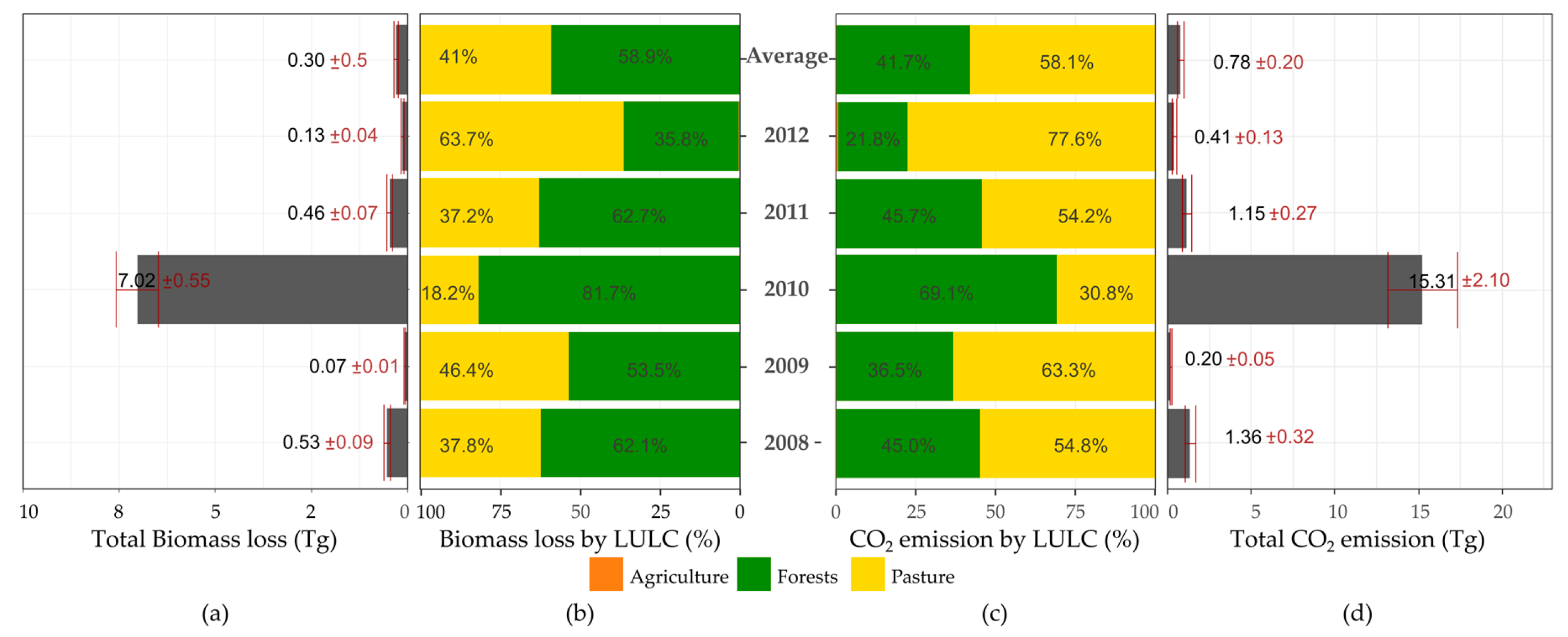
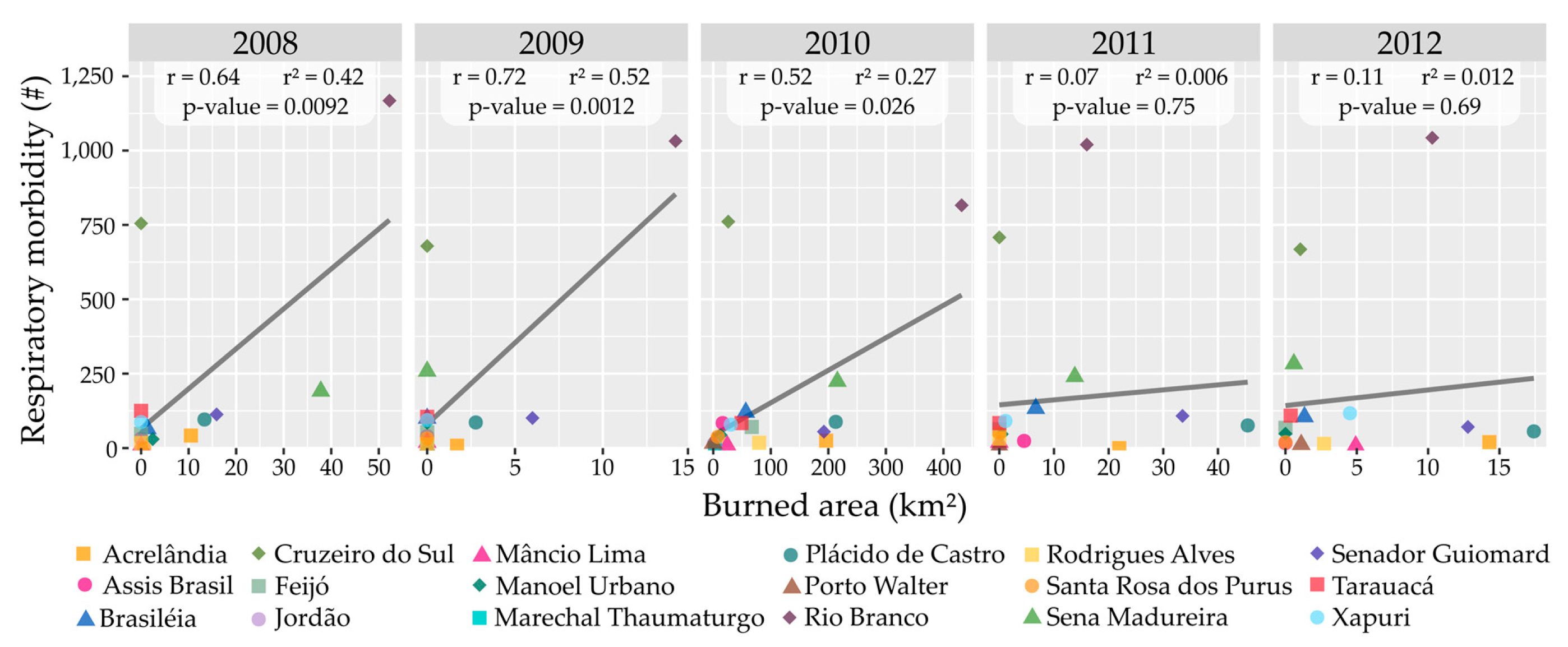
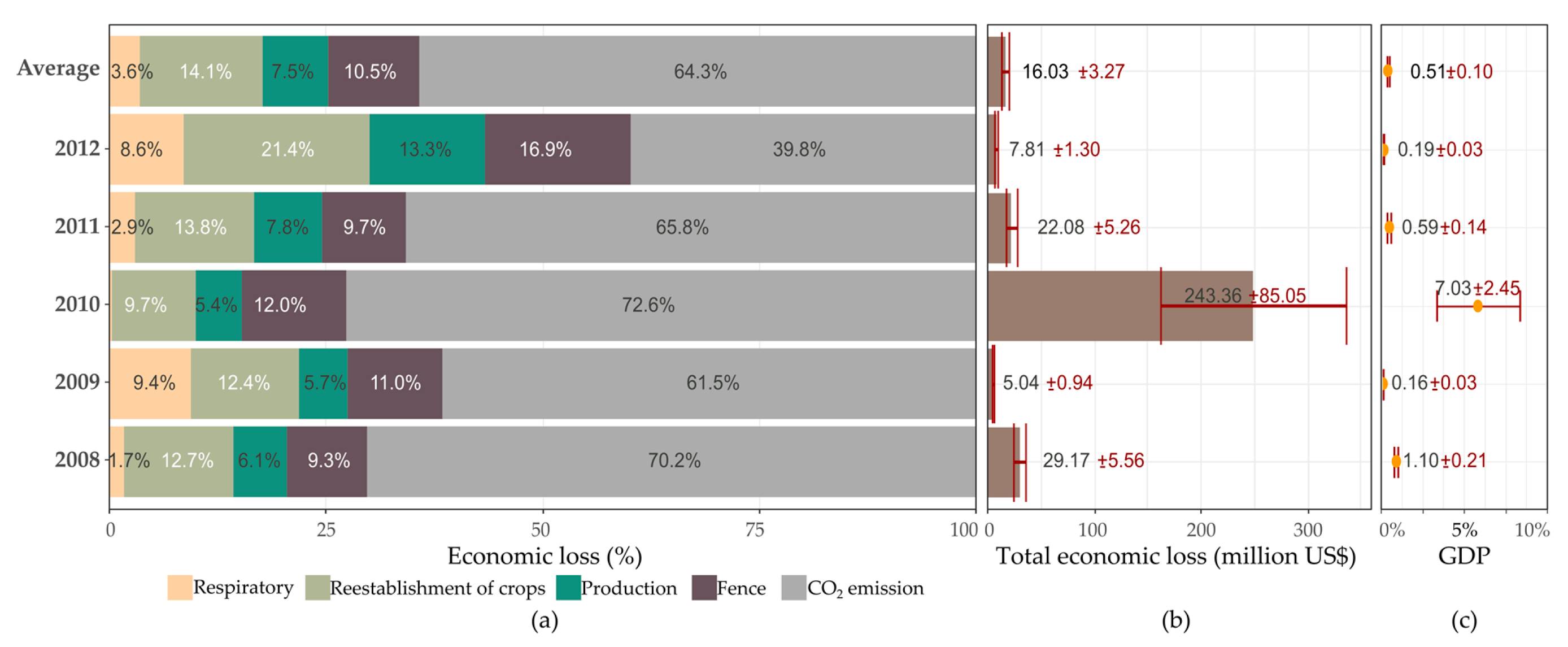
| TerraClass LULC Types | Grouped LULC Categories |
|---|---|
| Primary forests and secondary vegetation | Forests |
| Annual crops and Mosaic of uses | Agriculture |
| Herbaceous pasture, Scrubby pasture, Pasture with exposed soil and Regeneration with pasture | Pastures |
© 2019 by the authors. Licensee MDPI, Basel, Switzerland. This article is an open access article distributed under the terms and conditions of the Creative Commons Attribution (CC BY) license (http://creativecommons.org/licenses/by/4.0/).
Share and Cite
Campanharo, W.A.; Lopes, A.P.; Anderson, L.O.; da Silva, T.F.M.R.; Aragão, L.E.O.C. Translating Fire Impacts in Southwestern Amazonia into Economic Costs. Remote Sens. 2019, 11, 764. https://doi.org/10.3390/rs11070764
Campanharo WA, Lopes AP, Anderson LO, da Silva TFMR, Aragão LEOC. Translating Fire Impacts in Southwestern Amazonia into Economic Costs. Remote Sensing. 2019; 11(7):764. https://doi.org/10.3390/rs11070764
Chicago/Turabian StyleCampanharo, Wesley A., Aline P. Lopes, Liana O. Anderson, Thiago F. M. R. da Silva, and Luiz E. O. C. Aragão. 2019. "Translating Fire Impacts in Southwestern Amazonia into Economic Costs" Remote Sensing 11, no. 7: 764. https://doi.org/10.3390/rs11070764
APA StyleCampanharo, W. A., Lopes, A. P., Anderson, L. O., da Silva, T. F. M. R., & Aragão, L. E. O. C. (2019). Translating Fire Impacts in Southwestern Amazonia into Economic Costs. Remote Sensing, 11(7), 764. https://doi.org/10.3390/rs11070764








